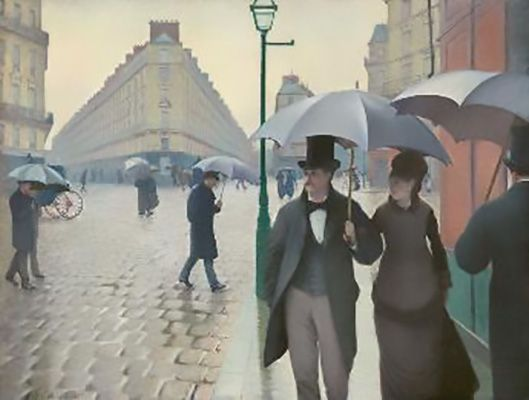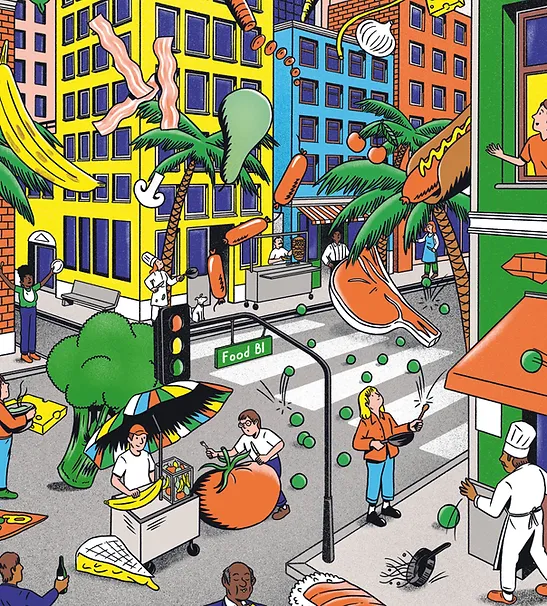Romantic Blog
Realist Style
Gustave Caillebotte, Paris Street, Rainy Day, 1875
This painting was was Gustave's second big painting. He created it in 1875, the same year he came out with The Floor Scrapers. His first work was not accepted well by the critics right away. "when Caillebotte exhibited Paris Street, Rainy Day along with five other paintings, the influential critic had a much more positive view of the artist's work." ("Gustave Caillebotte"). This painting is stunning to me. It almost looks like a blurry photo. I like the way he doesn't outline the people or buildings as it makes the painting look so much more real. Even with the choice of colors just goes along with the tone of the rainy day as he put in the title of the work.
Frederic Edwin Church, Tamaca Palms, 1854

Church was a painter apart of the Hudson River School. This school was well known for their realist style and were popular for their realistic landscape paintings. "Frederic Edwin Church and his fellow 19th-century landscape painters—many of whom were known as Hudson River School painters in accordance with the oft-depicted locale—extolled not only the natural wonders of the northeastern United States, but also those of the American West, South America, Europe, and the Near East, providing armchair travelers with views of exotic scenery most had never seen." (Church). I think landscape paintings are one of the most simple yet beautiful types of works. I think capturing a picturesque scene in nature cannot be beaten by many things. Church and his peers were masters at this as shown above. From the colors to the detail everything just looks great. In the end the simplistic themes, picturesque scenes, and use of color to convey tone is what attracts me to these types of works.
Art Nouveau
Gustav Klimt, The Tree of Life, Stoclet Frieze, 1905
Klimt was a painter from Austria who was popular for his works in the Nouveau style. Most of his works were oil paintings and usually were not landscape styled. "the mural also has another significance, being the only landscape created by the artist during his golden period." (“The Tree of Life, 1905 by Gustav Klimt”). The nouveau style is very confusing to me. The sporadic use of shapes and lines makes it hard for me to make out what is being portrayed. I don't mind the use of colors but it does not help me figure out what goes on in this painting. The people in the painting can only be recognized by their faces.
Alphonse Mucha, Slavia, 1908
Mucha is a Czech born painter and after looking through many of his works he seemed to have a lot of his paintings be used as ads. These ads were almost always in this nouveau style. This painting above is not an ad though. "Commissioned by the millionaire and philanthropist Charles Crane upon the marriage of his daughter Josephine, this painting is a portrait of Josephine as the Slav goddess, Slavia." (The Art Story). This painting is more appealing to me than the last but still proves that this style is too chaotic for my liking. The main person is depicted beautifully but then with the background I think it just does not fit. In the end the chaos, sporadic shapes, and hard to decipher aspects of nouveau are what drives me away.
References:
“Gustave Caillebotte.” The Art Story, 2017,
www.theartstory.org/artist/caillebotte-gustave/.
Church, Frederic Edwin. “Tamaca Palms,.” National Gallery of Art, 1854, www.nga.gov/collection/art-object-page.166437.html. Accessed 31 Mar. 2023.
The Art Story. “Alphonse Mucha.” The Art Story, 2016, www.theartstory.org/artist/mucha-alphonse/.
Gustav-klimt.com. “The Tree of Life, 1905 by Gustav Klimt.” Henri Matisse, 2011, www.gustav-klimt.com/The-Tree-Of-Life.jsp.





I really love the style of art nouveau. I know that it has a lot of vibrant colors and the structure may be different from other styles in the Romantic Era, but I think that is why I enjoy it so much. It gives a new perspective on art during the Romantic Era. The Realist style in my opinion is one of the styles that is alright to me, but it doesn't really grab my attention.
ReplyDeleteI definitely agree with your preference for realist art over art nouveau. The blend of colours and shapes in 'The Tree of Life' give me a bit of a headache if I look at it too long, and while it is rather beautiful, it doesn't really hold my attention as much as other art styles. 'Paris Street, Rainy Day', however, fully captures my eye! I love the use of shade and shapes to create a somewhat hazy look to the scene, as if you're looking through falling rain and having your vision blurred as a result. What's really interesting to me is the way the figures seem to gain more detail if you look at them more in your peripheral, and appear blurrier when you look at them head on. It's a really neat affect, likely attributed to the lack of any sharp lines!
ReplyDelete